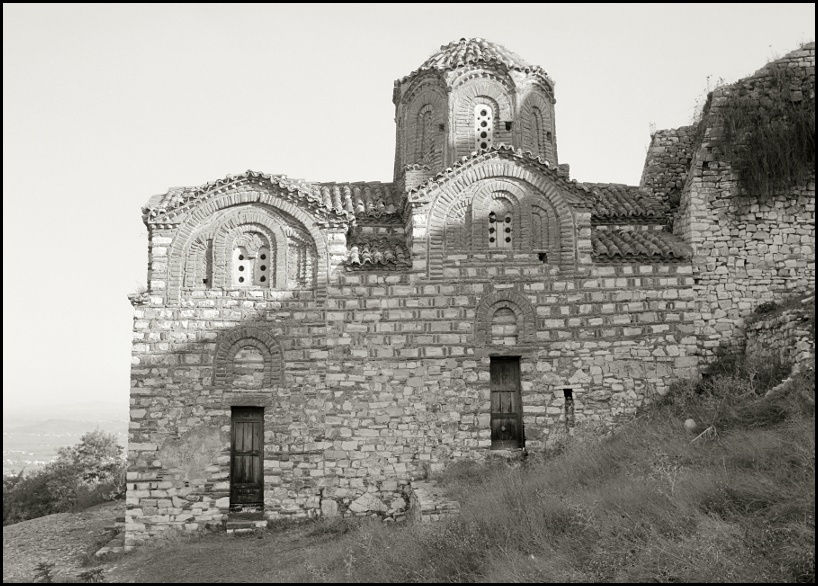structural reform...
I found this church to be one of the most attractive buildings within the hilltop castle. If I am understanding the guidebook correctly, this is the "Holy Trinity" (Shen Triadha) church, originally built in the 13th century. The layers of successive construction are clearly visible, and the red-brick arches built into the upper layers are especially striking. Services are still performed here once a week. I find that simple fact amazing, the sheer longevity and survival of a humble jumble of rock. Though old, it is maintained, modified, and still kept working. Once again, I am sorry to see, my own photographs of these great stoneworks fail badly. At least I find images such as these few from Berat castle boring and blah. They do not begin to convey the impressiveness of such antiquities when you stand with them in person. Among other things, what is missing here is human presence. Without a sense of life and purpose, I think images like this one are just cold and empty, without scale, disconnected and lifeless. Knowing this all too well from past experience, I like to ask the lovely Teshka to lend her graceful form as a model among the old stones. And so we did here in this very castle, Teshka posing beautifully in the archways and steps of these fine ancient structures. Sadly, though, most of those images did not "come out". And here I will mention a word or two about the camera... WARNING: geeky camera nonsense follows! The trip to Berat was the premiere outing of my Kodak Medalist, a vintage American medium format camera dating to about 1944. (Mine is a slightly earlier version of the camera shown here.) I had recently put the camera back into service after a challenging restoration. Once I got it working properly, I found the Medalist to be an interesting and fun machine, and capable of outstanding image characteristics. Although somewhat heavy and clunky, the retractable lens helical makes the camera especially compact for travel, with an overall volume not much larger than a Rolleiflex. I can easily carry the Medalist all day long in my smallest Domke shoulder bag. The portability of a camera is a crucial feature for our lifestyle. No matter where we go in the world, we either walk or take public transport. So if a camera can't sling over my shoulder, it just can't go. The promise of the Medalist, then, is in getting a big booming 6x9 negative, top-class Heliar-type lens, precision rangefinder focusing, and vintage image character, all wrapped up in a solid and compact package perfect for our type of travel. It nearly delivers on this promise, too. In its day, the Medalist represented a peak in American camera technology and production. Compared to the Voigtlander Bessa and Zeiss Super Ikonta of that same era, the Medalist was an absolute world beater in the realm of fine rollfilm photography. Even now, I'm not sure I can think of any lens made that can best the wonderful character and performance of the 100mm Ektar on this camera. But there is a rub. And no, the rub isn't that the Medalist was designed for now-obsolete 620 rollfilm. Sure, that is a small annoyance. But it is easily overcome by respooling 120 film onto 620 spools, and all part of the game in using many old vintage cameras anyway. The problem is that, internally, the Medalist is a bit of a Rube Goldberg contraption. Although it has many swell features like automatic film advance, automatic shutter cocking, double-exposure prevention, top-deck frame counter, and viewfinder parallax correction, the mechanical implementation of all these niceties is not especially elegant. And nowhere is the lack of engineering elegance worse than in the shutter release button. The Medalist requires an especially long deep push to trip the shutter, and substantial amounts of finger pressure to get the job done against a lot of internal springs and linkages. As you push and push and still push some more, you hear and feel all these intermediate clicks and clacks and sproings going off inside the camera, until at long last the shutter finally gets tripped, way out there at the far end of the focusing helical. The pressure, imprecision, and lack of "feel" in this shutter release is the major usability defect of the Medalist. It is very difficult to hold this camera steady while making an exposure with its release button, without blurring the image. And that is exactly what happened in far too many of my photographs in Berat. I got icky blurry images from camera movement during the moment of exposure, all due to that pesky shutter release. So, instead of the deliciously crisp and tasty images the camera delivered here and here, I got way too many horrible blurry images like this one instead. And with only 8 frames per roll to work with, this kind of failure rate is tragic! Anyway, after considering the problem further, I think I have come up with an idea for the next outing with the Medalist. Rather than using the shutter release on top of the camera, I will try using a cable release attached directly to the shutter itself. While this will undoubtedly reduce some of the automatic "convenience" in using the camera, I'm hoping the technique will stop those conveniences from spoiling so many images. Sometimes to keep using something that is old, you just need to work out different ways of using it. Berat, Albania, October 2011. Kodak Medalist, 100mm f/3.5 Ektar (1945), Ilford HP5. |
